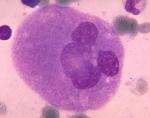How to tell apart blood and marrow smears

We mentioned at the description of the pathophysiology
exam that you get an unlabeled or coded smear you will have to
find out if it is a blood or a bone marrow specimen. This problem
rarely arises in real life, because the physician usually knows where he
got the specimen from. However, we decided to organize the exam
this way, for the following reasons:
- it is easy to tell the difference
- this makes it somewhat easier for the examiner to judge the knowledge
of the student
Here are a few ways to tell the difference between blood and bone marrow
specimens (you should probably use more than one method):
You can tell if a smear is made of peripheral blood or bone marrow
many times just by looking at it. Peripheral blood forms a homogenous
layer on the glass plate, without any apparent structure. On the
other hand, bone marrow smears are not homogenous, the inner
portions look different from those at the sides.
The situation is similar to the macroscopic examination: the peripheral
blood preparations are homogenous, while the bone marrow ones are not.
You can often see empty areas in the bone marrow, corresponding to
dissolved fat, the inner areas look different from those at the
sides.

| Normal peripheral blood smear, homogenous picture.
the WBC count is normal.
|

| Normal bone marrow. The fat dissolved during the staining procedure
leaves apparently empty areas.
|

| The side portion of a normal peripheral blood smear. You may see
some inhomogeneity here. Don't mix this up with a bone marrow preparation!
This shows that you really need to examine a preparation at many
places, not just one.
|

| CML peripheral blood. The high WBC count is charateristic.
|

| AL in peripheral blood. The WBC count is variable, here it is high.
|

| Hypercellular bone marrow in CML. The megakaryocyte count is
often increased in the first phase of the disease.
|
There are cells that never get out to the peripheral blood, even
under pathological conditions. (To be precise: any cell can get out,
but some cells appear in the peripheral blood very rarely,
and they have rather unusual morphological characteristics when they
do so.) So, if we see a cell like like this (e.g. plasmocyte or
megakaryocyte) we know that the specimen we are looking at is probably
a bone marrow one. A few normoblasts often appear in peripheral
blood films of leukemic patients, because they usually have anemia.
That is why normoblasts are not very good to tell the difference
between blood and bone marrow. (If you see really large number
of normoblasts, then it is likely to be bone marrow, of course.)
Plasmacytes rarely get out to the peripheral blood. The so
called plasmocytic leukemia is such a rare condition. So if you see
plasmacytes, in a smear it is likely to be bone marrow.
Megakaryocytes very do not get out to the peripheral blood.
There is a condition called megakaryoblastic leukamia (FAB M7),
where the tumor cells appear in the peripheral blood, but these
cells are small, and don't look like the normal megakaryocytes
in the normal bone marrow. So megakaryocytes are very useful
in differentiating blood from bone marrow: if you see one, you
know it is a bone marrow specimen. The only problem is, that
there are very few of them in the bone marrow, so you must be
lucky to find one with the usual high magnification. You can
easily find them, however, using a low magnification, because
of their enormous size.

| Megakaryocyte in a bone marrow, using low magnification.
This field looks like peripheral blood, but the presence of the
megakaryocyte rules this out. In situations like this, it is
a good idea to put the megakaryocyte precisely into the middle
of the field, and to change over to high magnification, so that
you can see if it is really a megakaryocyte or not. This is
the following picture.
|

| The same megakaryocyte using high magnification.
|
László L. Tornóci
Copyright © Inst. Pathophysiology,
Semmelweis Medical University






